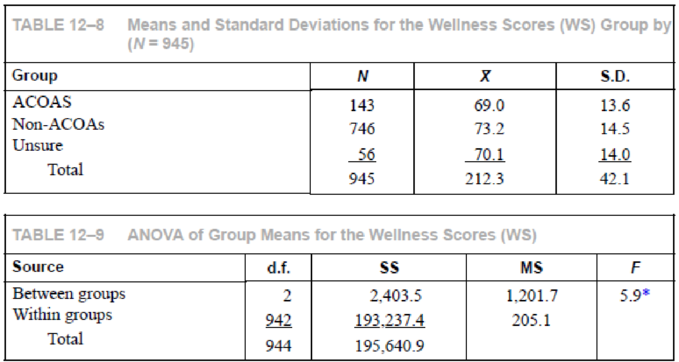
Adult Children of Alcoholics
Shown here are the abstract and two tables from a research study entitled “Adult Children of Alcoholics: Are They at Greater Risk for Negative Health Behaviors?” by Arlene E. Hall. Based on the abstract and the tables, answer these questions.
Abstract The purpose of the study was to examine and compare the health behaviors of adult children of alcoholics (ACOAs) and their non-ACOA peers within a university population. Subjects were 980 undergraduate students from a major university in the East. Three groups (ACOA, non-ACOA, and Unsure) were identified from subjects’ responses to three direct questions regarding parental drinking behaviors. A questionnaire was used to collect data for the study. Included were questions related to demographics, parental drinking behaviors, and the College Wellness Check (WS), a health risk appraisal designed especially for college students (Dewey & Cabral, 1986). Analysis of variance procedures revealed that ACOAs had significantly lower wellness scores (WS) than non-ACOAs. Chi-square analyses of the individual variables revealed that ACOAs and non-ACOAs were significantly different on 15 of the 50 variables of the WS. A discriminant analysis procedure revealed the similarities between Unsure subjects and ACOA subjects. The results provide valuable information regarding ACOAs in a nonclinical setting and contribute to our understanding of the influences related to their health risk behaviors.

*p < 0.01
8. Why was the one-way ANOVA procedure used, as opposed to another test, such as the t test?
Want to see the full answer?
Check out a sample textbook solution
Chapter 12 Solutions
ALEKS 360 BLUMAN ELE.STAT:A STEP.(11WKS)
- Urban Travel Times Population of cities and driving times are related, as shown in the accompanying table, which shows the 1960 population N, in thousands, for several cities, together with the average time T, in minutes, sent by residents driving to work. City Population N Driving time T Los Angeles 6489 16.8 Pittsburgh 1804 12.6 Washington 1808 14.3 Hutchinson 38 6.1 Nashville 347 10.8 Tallahassee 48 7.3 An analysis of these data, along with data from 17 other cities in the United States and Canada, led to a power model of average driving time as a function of population. a Construct a power model of driving time in minutes as a function of population measured in thousands b Is average driving time in Pittsburgh more or less than would be expected from its population? c If you wish to move to a smaller city to reduce your average driving time to work by 25, how much smaller should the city be?arrow_forwardWhat is meant by the sample space of an experiment?arrow_forwardWhat is an experiment?arrow_forward
 Functions and Change: A Modeling Approach to Coll...AlgebraISBN:9781337111348Author:Bruce Crauder, Benny Evans, Alan NoellPublisher:Cengage Learning
Functions and Change: A Modeling Approach to Coll...AlgebraISBN:9781337111348Author:Bruce Crauder, Benny Evans, Alan NoellPublisher:Cengage Learning Glencoe Algebra 1, Student Edition, 9780079039897...AlgebraISBN:9780079039897Author:CarterPublisher:McGraw Hill
Glencoe Algebra 1, Student Edition, 9780079039897...AlgebraISBN:9780079039897Author:CarterPublisher:McGraw Hill Big Ideas Math A Bridge To Success Algebra 1: Stu...AlgebraISBN:9781680331141Author:HOUGHTON MIFFLIN HARCOURTPublisher:Houghton Mifflin Harcourt
Big Ideas Math A Bridge To Success Algebra 1: Stu...AlgebraISBN:9781680331141Author:HOUGHTON MIFFLIN HARCOURTPublisher:Houghton Mifflin Harcourt Holt Mcdougal Larson Pre-algebra: Student Edition...AlgebraISBN:9780547587776Author:HOLT MCDOUGALPublisher:HOLT MCDOUGAL
Holt Mcdougal Larson Pre-algebra: Student Edition...AlgebraISBN:9780547587776Author:HOLT MCDOUGALPublisher:HOLT MCDOUGAL College Algebra (MindTap Course List)AlgebraISBN:9781305652231Author:R. David Gustafson, Jeff HughesPublisher:Cengage Learning
College Algebra (MindTap Course List)AlgebraISBN:9781305652231Author:R. David Gustafson, Jeff HughesPublisher:Cengage Learning





